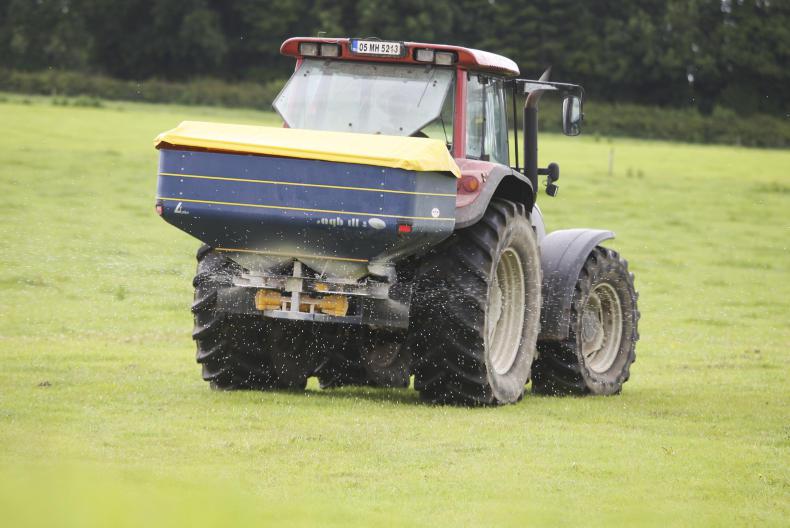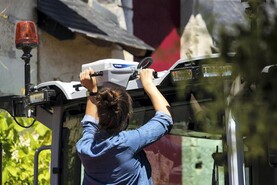Buying a new fertiliser spreader isn’t always a financially viable or a justifiable option for some farmers. The secondhand market often offers value for money with many well-minded machines that still have years of use in them.
Buying a used spreader is no different to buying any used machine. The machine should be inspected both visually and physically. In most cases, the first glance will tell a lot about how the machine was maintained by its previous owner.
The majority of farmers buying a spreader will be after a twin-disc machine, these being the most common on the market.
General overall condition
The general physical condition of a fertiliser spreader is particularly important. With artificial fertiliser being a corrosive product, protective maintenance is key. If a spreader is not washed down and sprayed with oil after each use before storage, rust and corrosion will quickly become an issue regardless of age.
Faded paintwork or even rust along with weathered or dull-looking plastic components will generally indicate that the spreader spent its days stored outdoors exposed to the elements. Dry storage isn’t always possible but is key to the proper maintenance and long working life of any machine.
Chassis and hopper
Chassis condition should be closely examined, checking for damage, cracks or even strain – a common result of overloading.
Check three-point linkage mountings for cracks. Many machines’ chassis have bends and folds in the metalwork for added strength. These nooks and crannies often contain lodged fertiliser. If washing wasn’t thorough, rust may have set in.

This is a prime example of a spreader whose chassis is strained from overloading.
Likewise with the spreader’s hopper. It should be examined for rust or damage. A hopper that was heavily overloaded may have cracked or split corners. All nuts and bolts should be present and tight, loose bolts create movement within components which over time may damage paintwork and allow rust to set in.
Gearbox and slip clutch
It’s not recommended to buy a fertiliser spreader without having seen it working. The spreader should be mounted on a tractor and its gearbox checked over. Machines fitted with an oil-filled gearbox should have oil level and quality examined. Milky looking oil generally indicates seal failure where water has entered.
Gearboxes on all spreaders should appear dry externally, showing no signs of oil leaks (often obvious if dirty as dust sticks to oil residue). Many manufacturers say gearbox oil should last the spreader’s lifetime, although it’s good practice to check levels every season and change it every few years.

The slip clutch should be checked and in good working order.
In many cases, if the gearbox is in need of major repair it often works out cheaper to replace it entirely rather than go down the path of refurbishment.
Slip clutches should be functioning. A non-operational slip clutch on PTO start-up (especially under load) causes gearbox damage. On Bogballe machines in particular, this will result in the gearbox sticking in either headland or non-headland mode, so it’s always worth moving the spreader in and out of headland mode (if fitted) ensuring the gearbox slots into the position selected. Any spreader fitted with a headland kit should be checked to ensure it works.
Discs and vanes
Disc and spreading vane condition is very important for consistent and accurate spreading. Vanes should be mounted in the correct positions and secure. The vane’s leading edge should be straight and its face that comes into contact with fertiliser should be smooth.
A new set of genuine vanes to fit a typical farmer-specification machine will cost in the region of €350 to €400 plus VAT. Discs don’t wear but it is important to assess their condition, and ensure that they are damage-free.

Spreading vanes with a wrinkled effect and a worn leading edge need to be replaced as the spread pattern will be effected.
Check each disc for excessive play or rocking. This would indicate gearbox bearing issues. Typically minor play (1mm) will be okay but anything more will need attention and if replacing one then replace the other for peace of mind.
Hopper shutters/agitators
Different manufacturers may use single or twin shutter designs. Regardless of design, shutters should open and close to an equal width. On Bogballe machines, shutters should close to the notch and read zero on the scale facing the tractor cab. Shutters can be adjusted on all machines so ensure they are operating properly before buying.

Hopper condition should be checked and grills if present in good condition.
The ram and spring setup that operates the shutters should be checked ensuring its seal is not leaking oil. When checking this, check the condition of the hydraulic hose and coupling. Agitators, like shutters, are important for consistent, even flow of fertiliser. Physical condition is important. Broken or damaged agitators will affect flow. There are different systems such as finger or spiral agitators. All agitators, horizontal and vertical, need to be checked for bearing play.
On Bogballe machines where only vertical offset agitators are present, movement in the top half of the agitator indicates top bearing issues. Play in the lower half of the agitator will indicate that the bearing in the top of the gearbox needs replaced.
Hopper cover and grills
Many twin-disc machines are fitted with grills. These grills have a number of purposes. They protect foreign objects or lumps coming into contact with agitators and causing damage. They also prevent the risk of a person falling or coming into contact with the agitators or shutters. These grills are held in place with small latches and hinges, these should be present and not broken. As is the case with loose bolts, loose hinges or latches can rub of the hopper and damage the painted surface.
A hopper cover is not essential but a good feature to have, keeping water and dirt out. If fitted, the canvas should be free from cuts or damage and the condition of its frame checked.
Small cuts may be repairable and a more economical solution to buying a new canvas which may prove costly.
It’s not unusual for weather over a number of years to deteriorate the spreader’s cover.
Safety
It goes without saying that every spreader should be fitted with a good operational PTO shaft whereby covers and safety chains are present. Universal joints on both ends of the PTO shaft should be inspected for wear. Hydraulic hoses should be examined for damage, perishing or leakages. Where present taps to isolate flow should be working.
Larger mounted machines with extensions fitted that block the view of the tractors tail lights should have their own lights and reflectors fitted. Ensure these lights are present and functional. Mudguards if fitted should not be torn or cut, as these prevent fertiliser from being thrown at the tractor as well as muck being thrown on to the spreader.
Buying a new fertiliser spreader isn’t always a financially viable or a justifiable option for some farmers. The secondhand market often offers value for money with many well-minded machines that still have years of use in them.
Buying a used spreader is no different to buying any used machine. The machine should be inspected both visually and physically. In most cases, the first glance will tell a lot about how the machine was maintained by its previous owner.
The majority of farmers buying a spreader will be after a twin-disc machine, these being the most common on the market.
General overall condition
The general physical condition of a fertiliser spreader is particularly important. With artificial fertiliser being a corrosive product, protective maintenance is key. If a spreader is not washed down and sprayed with oil after each use before storage, rust and corrosion will quickly become an issue regardless of age.
Faded paintwork or even rust along with weathered or dull-looking plastic components will generally indicate that the spreader spent its days stored outdoors exposed to the elements. Dry storage isn’t always possible but is key to the proper maintenance and long working life of any machine.
Chassis and hopper
Chassis condition should be closely examined, checking for damage, cracks or even strain – a common result of overloading.
Check three-point linkage mountings for cracks. Many machines’ chassis have bends and folds in the metalwork for added strength. These nooks and crannies often contain lodged fertiliser. If washing wasn’t thorough, rust may have set in.

This is a prime example of a spreader whose chassis is strained from overloading.
Likewise with the spreader’s hopper. It should be examined for rust or damage. A hopper that was heavily overloaded may have cracked or split corners. All nuts and bolts should be present and tight, loose bolts create movement within components which over time may damage paintwork and allow rust to set in.
Gearbox and slip clutch
It’s not recommended to buy a fertiliser spreader without having seen it working. The spreader should be mounted on a tractor and its gearbox checked over. Machines fitted with an oil-filled gearbox should have oil level and quality examined. Milky looking oil generally indicates seal failure where water has entered.
Gearboxes on all spreaders should appear dry externally, showing no signs of oil leaks (often obvious if dirty as dust sticks to oil residue). Many manufacturers say gearbox oil should last the spreader’s lifetime, although it’s good practice to check levels every season and change it every few years.

The slip clutch should be checked and in good working order.
In many cases, if the gearbox is in need of major repair it often works out cheaper to replace it entirely rather than go down the path of refurbishment.
Slip clutches should be functioning. A non-operational slip clutch on PTO start-up (especially under load) causes gearbox damage. On Bogballe machines in particular, this will result in the gearbox sticking in either headland or non-headland mode, so it’s always worth moving the spreader in and out of headland mode (if fitted) ensuring the gearbox slots into the position selected. Any spreader fitted with a headland kit should be checked to ensure it works.
Discs and vanes
Disc and spreading vane condition is very important for consistent and accurate spreading. Vanes should be mounted in the correct positions and secure. The vane’s leading edge should be straight and its face that comes into contact with fertiliser should be smooth.
A new set of genuine vanes to fit a typical farmer-specification machine will cost in the region of €350 to €400 plus VAT. Discs don’t wear but it is important to assess their condition, and ensure that they are damage-free.

Spreading vanes with a wrinkled effect and a worn leading edge need to be replaced as the spread pattern will be effected.
Check each disc for excessive play or rocking. This would indicate gearbox bearing issues. Typically minor play (1mm) will be okay but anything more will need attention and if replacing one then replace the other for peace of mind.
Hopper shutters/agitators
Different manufacturers may use single or twin shutter designs. Regardless of design, shutters should open and close to an equal width. On Bogballe machines, shutters should close to the notch and read zero on the scale facing the tractor cab. Shutters can be adjusted on all machines so ensure they are operating properly before buying.

Hopper condition should be checked and grills if present in good condition.
The ram and spring setup that operates the shutters should be checked ensuring its seal is not leaking oil. When checking this, check the condition of the hydraulic hose and coupling. Agitators, like shutters, are important for consistent, even flow of fertiliser. Physical condition is important. Broken or damaged agitators will affect flow. There are different systems such as finger or spiral agitators. All agitators, horizontal and vertical, need to be checked for bearing play.
On Bogballe machines where only vertical offset agitators are present, movement in the top half of the agitator indicates top bearing issues. Play in the lower half of the agitator will indicate that the bearing in the top of the gearbox needs replaced.
Hopper cover and grills
Many twin-disc machines are fitted with grills. These grills have a number of purposes. They protect foreign objects or lumps coming into contact with agitators and causing damage. They also prevent the risk of a person falling or coming into contact with the agitators or shutters. These grills are held in place with small latches and hinges, these should be present and not broken. As is the case with loose bolts, loose hinges or latches can rub of the hopper and damage the painted surface.
A hopper cover is not essential but a good feature to have, keeping water and dirt out. If fitted, the canvas should be free from cuts or damage and the condition of its frame checked.
Small cuts may be repairable and a more economical solution to buying a new canvas which may prove costly.
It’s not unusual for weather over a number of years to deteriorate the spreader’s cover.
Safety
It goes without saying that every spreader should be fitted with a good operational PTO shaft whereby covers and safety chains are present. Universal joints on both ends of the PTO shaft should be inspected for wear. Hydraulic hoses should be examined for damage, perishing or leakages. Where present taps to isolate flow should be working.
Larger mounted machines with extensions fitted that block the view of the tractors tail lights should have their own lights and reflectors fitted. Ensure these lights are present and functional. Mudguards if fitted should not be torn or cut, as these prevent fertiliser from being thrown at the tractor as well as muck being thrown on to the spreader.










 This is a subscriber-only article
This is a subscriber-only article










SHARING OPTIONS: